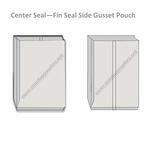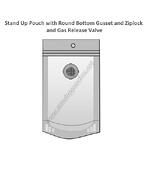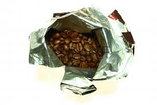Having been in the flexible packaging business for over 30 years, we get asked a lot of questions. A number of those questions pertain to concerns and worries companies have using foil coffee bags. Foil coffee bags and pouches have been used for a long time and much has changed over the years, and it is our hope that these 5 bullet points are helpful for coffee roasters, coffee retailers, and anyone else using coffee packaging.
Times have changed but one thing continues to remain, and that is the need to properly protect what many of us consider a precious commodity, the coffee bean. Here are 5 potential problems with foil coffee bags along with some simple solutions.
1. Foil
It is considered heresy to use any other material to package coffee except foil and in my opinion this is wrong and outdated. Coffee pouches made with barrier film that consists of foil has been around since we started packaging coffee at the retail level, probably because there weren’t any alternatives. While foil does provide great barrier properties, it remains one of the most expensive films available. Further once foil is bent or folded, there is no spring or return on the film leaving creases, folds, and often weakens in this area and tears. Foil itself is only one small part of the film layer and similar to the foil we use at home to cover a roast or a turkey it isn’t very strong. Recent advancements in film structures such as metalized film as well as clear ones are incredibly strong, resilient, can flex, have extremely solid barrier properties and cost less than foil. Keep this in mind the next time you are quoting your coffee packaging.
2. Poor Gas Valves
When coffee beans are roasted they give off twice their volume in carbon dioxide. If this outgas doesn’t have the ability to release the foil coffee bags will burst. This gas is released by a one-way gas valve inserted and embedded into the coffee pouch and allows the gas to escape while not allowing oxygen into the bag. As anyone can imagine, there are good gas valves and cheap inexpensive gas valves and rarely does cheaper mean better quality. Swiss made gas valves have historically been the most expensive but most reliable and effective. Cheap Chinese gas valves are just that, cheap and don’t work very well. You will get what you pay for.
3. Stability
 Foil coffee bags have been made in two styles almost exclusively for years. If packaged by hand or semi-automatic filler a quad seal bag has been used whereas if everything is done automatically where the film is folded and sealed and formed then inserted with coffee, this style is known as a center seal or fin style bag. Both of these styles work great when they are full and sealed properly but as soon as the bag is opened they slouch and often fold over.
Foil coffee bags have been made in two styles almost exclusively for years. If packaged by hand or semi-automatic filler a quad seal bag has been used whereas if everything is done automatically where the film is folded and sealed and formed then inserted with coffee, this style is known as a center seal or fin style bag. Both of these styles work great when they are full and sealed properly but as soon as the bag is opened they slouch and often fold over.
 New designs and some refreshed older ones are making a comeback. The traditional stand up pouch style with a round or K bottom gusset stand erect on a shelf and are very popular with consumers and retailers alike while the newest style known as a Flexible Box Bag mimics a box or folding carton and stands erect while it has a few other inherent benefits, one it uses up to 15% less film and because of the side gussets holds more volume in a smaller size/area.
New designs and some refreshed older ones are making a comeback. The traditional stand up pouch style with a round or K bottom gusset stand erect on a shelf and are very popular with consumers and retailers alike while the newest style known as a Flexible Box Bag mimics a box or folding carton and stands erect while it has a few other inherent benefits, one it uses up to 15% less film and because of the side gussets holds more volume in a smaller size/area.
4. Ziplock Closures
The Quad Seal and the Center Seal Fin Style do not perform well with a ziplock. These styles are square and a zipper closure restricts how wide the pouch can open. Subsequently additional items such as tin ties or stick on labels are required to close the pouch, which can be cumbersome. Traditional stand up pouches and flexible box bags do not have this problem and work very well with ziplocks and do not need tin ties, press on labels or other closures.
5. Freshness
 Foil coffee bags that are made in the Quad Seal and/or Center Seal Fin Style (as most coffee packaging is done these days) don’t stand effectively on a shelf and the ability to seal the package effectively with a tin tie or press on label just doesn’t work very well. Oxygen and moisture are killers for coffee freshness and trusting these closures isn’t recommended.
Foil coffee bags that are made in the Quad Seal and/or Center Seal Fin Style (as most coffee packaging is done these days) don’t stand effectively on a shelf and the ability to seal the package effectively with a tin tie or press on label just doesn’t work very well. Oxygen and moisture are killers for coffee freshness and trusting these closures isn’t recommended.
In closing, we all know how precious the coffee bean is to our morning and evening routines. It is our hope that these 5 bullet points will help as you review your current use of coffee packaging or develop it from scratch. Make sure you grab our Coffee Packaging eBook below and get your free packaging samples also!







